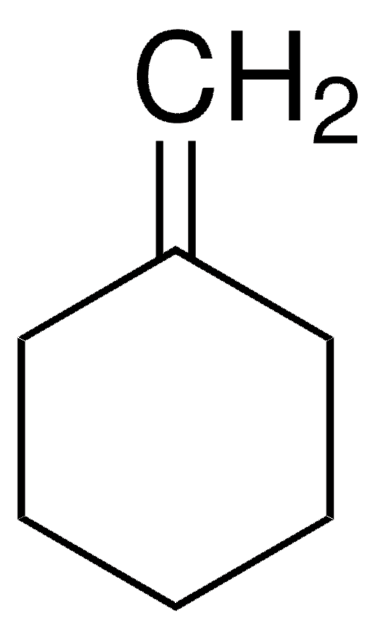추천 제품
Grade
analytical standard
Quality Level
vapor density
3.76 (vs air)
vapor pressure
10.2 mmHg ( 25 °C)
분석
≥99.5% (GC)
autoignition temp.
517 °F
유통기한
limited shelf life, expiry date on the label
기술
HPLC: suitable
gas chromatography (GC): suitable
refractive index
n20/D 1.463 (lit.)
n20/D 1.464
bp
126-127 °C (lit.)
mp
−101 °C (lit.)
density
0.831 g/mL at 20 °C
0.831 g/mL at 20 °C
0.832 g/mL at 25 °C (lit.)
응용 분야
environmental
petroleum
형식
neat
저장 온도
2-8°C
SMILES string
C=CC1CCC=CC1
InChI
1S/C8H12/c1-2-8-6-4-3-5-7-8/h2-4,8H,1,5-7H2
InChI key
BBDKZWKEPDTENS-UHFFFAOYSA-N
유사한 제품을 찾으십니까? 방문 제품 비교 안내
일반 설명
4-Vinyl-1-cyclohexene can be synthesized via cyclo-dimerization of butadiene in the presence of nitrosyl iron catalysts like [Fe(NO)2(CO)2] or [{FeCl(NO)2}2]/reductant.
애플리케이션
Refer to the product′s Certificate of Analysis for more information on a suitable instrument technique. Contact Technical Service for further support.
추천 제품
Find a digital Reference Material for this product available on our online platform ChemisTwin® for NMR. You can use this digital equivalent on ChemisTwin® for your sample identity confirmation and compound quantification (with digital external standard). An NMR spectrum of this substance can be viewed and an online comparison against your sample can be performed with a few mouseclicks. Learn more here and start your free trial.
신호어
Danger
유해 및 위험 성명서
Hazard Classifications
Aquatic Chronic 3 - Asp. Tox. 1 - Carc. 2 - Flam. Liq. 2 - Repr. 2 - Skin Irrit. 2
Storage Class Code
3 - Flammable liquids
WGK
WGK 2
Flash Point (°F)
60.8 °F - closed cup
Flash Point (°C)
16 °C - closed cup
개인 보호 장비
Eyeshields, Faceshields, Gloves, type ABEK (EN14387) respirator filter
이미 열람한 고객
Inorganic Reactions and Methods, Reactions Catalyzed by Inorganic Compounds (2009)
Ellen A Cannady et al.
Toxicological sciences : an official journal of the Society of Toxicology, 68(1), 24-31 (2002-06-21)
Microsomal epoxide hydrolase (mEH) is involved in the detoxification of xenobiotics that are or can form epoxide metabolites, including the ovotoxicant, 4-vinylcyclohexene (VCH). This industrial chemical is bioactivated by hepatic CYP450 to the diepoxide metabolite, VCD, which destroys mouse small
C Bevan et al.
Fundamental and applied toxicology : official journal of the Society of Toxicology, 32(1), 1-10 (1996-07-01)
This study was conducted to evaluate the subchronic toxicity of 4-vinylcyclohexene (VCH). Male and female Sprague-Dawley rats and B6C3F1 mice were exposed by inhalation to VCH 6 hr/day, 5 days/week for 13 weeks. Rats were exposed to 0, 250, 1000
Ellen A Cannady et al.
Toxicological sciences : an official journal of the Society of Toxicology, 73(2), 423-430 (2003-04-18)
4-Vinylcyclohexene (VCH), an occupational chemical, causes destruction of small preantral follicles (F1) in mice. Previous studies suggested that VCH is bioactivated via cytochromes P450 (CYP450) to the ovotoxic, diepoxide metabolite, VCD. Whereas hepatic CYP450 isoforms 2E1, 2A, and 2B can
J K Doerr-Stevens et al.
Drug metabolism and disposition: the biological fate of chemicals, 27(2), 281-287 (1999-02-04)
4-Vinylcyclohexene (VCH), an ovarian toxicant in mice, is known to irreversibly deplete ovarian follicles as a consequence of VCH diepoxide formation. Because ovotoxicity requires repeated dosing of VCH, the effect of consecutive daily doses of VCH (7.5 mmol/kg/day) on mouse
자사의 과학자팀은 생명 과학, 재료 과학, 화학 합성, 크로마토그래피, 분석 및 기타 많은 영역을 포함한 모든 과학 분야에 경험이 있습니다..
고객지원팀으로 연락바랍니다.












